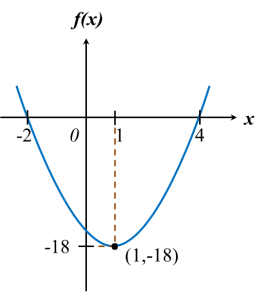Question 1:
Find the minimum value of the function f (x) = 2x2 + 6x + 5. State the value of xthat makes f (x) a minimum value.
Solution:
By completing the square for f (x) in the form of f (x) = a(x + p)2 + q to find the minimum value of f (x).
Since a = 2 > 0,
Therefore
f (
x) has a minimum value when
. The minimum value of
f (
x) = ½.
Question 2:
The quadratic function f (x) = –x2 + 4x + k2, where k is a constant, has a maximum value of 8.
Find the possible values of k.
Solution:
f (x) = –x2 + 4x + k2
f (x) = –(x2 – 4x) + k2 ← [completing the square for f (x) in
the form of f (x) = a(x + p)2+ q]
f (x) = –[x2 – 4x + (–2)2 – (–2)2] + k2
f (x) = –[(x – 2)2 – 4] + k2
f (x) = –(x – 2)2 + 4 + k2
Given the maximum value is 8.
Therefore, 4 + k2 = 8
k2 = 4
k = ±2


